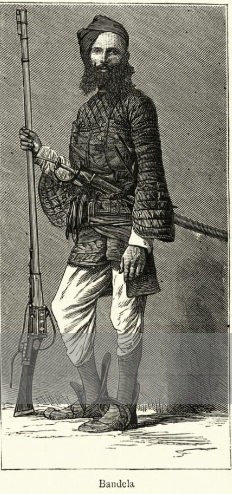
Bundelkhand is a geographical and cultural region and a proposed state and also a mountain range in central & North India. The hilly region is now divided between the states of Uttar Pradesh and Madhya Pradesh, with the larger portion lying in the latter state.

Vindhya Pradesh was a former state of India. It occupied an area of 61,131.5 km2. It was created in 1948 as Union of Baghelkhand and Bundelkhand States, shortly after Indian independence, from the territories of the princely states in the eastern portion of the former Central India Agency. It was named as Vindhya Pradesh on 25 January 1950 after the Vindhya Range, which runs through the centre of the province. The capital of the state was the former princely state of Rewa. It lays between Uttar Pradesh to the north and Madhya Pradesh to the south, and the enclave of Datia, which lay a short distance to the west, was surrounded by the state of Madhya Bharat.

The Central India Agency was created in 1854, by amalgamating the Western Malwa Agency with other smaller political offices which formerly reported to the Governor-General of India. The agency was overseen by a political agent who maintained relations of the Government of India with the princely states and influence over them on behalf of the Governor-General. The headquarters of the agent were at Indore.

Datia is the district headquarter of the Datia District in north central Madhya Pradesh, a state of Central India. It is an ancient town, mentioned in the Mahabharata ruled by King Dantavakra. The city is 78 km from Gwalior, 325 km south of New Delhi and 344 km north of Bhopal. About 18 km from Datia is Sonagiri, a sacred Jain hill. Datia is also about 31 km from Jhansi and 52 km from Orchha. The nearest airport is at Gwalior. It was formerly the seat of the eponymous princely state in the British Raj. Datia is situated near Gwalior and on the border with Uttar Pradesh.

Cooch Behar, also known as Koch Bihar, was a princely state in India during the British Raj. The state was placed under the Bengal States Agency, part of the Eastern States Agency of the Bengal Presidency. It is located south of the Himalayan kingdom of Bhutan, in present-day West Bengal.

Datia District is in Gwalior Division in the Indian state of Madhya Pradesh. The town of Datia is its district headquarters.

The Bundela is a Rajput clan. Over several generations, the cadet lineages of Bundela Rajputs founded several states in area what came to be known as Bundelkhand anciently known as Chedi Kingdom from the 16th century.

The Bundelkhand Agency was a political agency of the British Raj, managing the relations of the British government with the protected princely states of the Bundelkhand region.
Samthar is a city and a municipal board in Jhansi district in the Indian state of Uttar Pradesh. Historically before independence of India, it was also known as Samshergarh erstwhile capital of Samthar State

Maharaja Jawahar Singh was a Jat ruler of the Bharatpur State. He succeeded to the throne when his father Suraj Mal died in 1763.

Raja Nain Singh Nagar also known as Raja Nain Singh Gurjar of Parichhatgarh was a Gurjar king in Bahsuma town of Meerut district in the Indian state of Uttar Pradesh during the 18th century. He was one of the notable Gurjar Kings of that time, other being Raja Ram Dayal Singh Gurjar of Landhaura, and Rao Ajit Singh Gurjar of Dadri and many more.

Datia State was a princely state in subsidiary alliance with British India.

Orchha State was a kingdom situated in the Bundelkhand region and later a princely state in British India. The state was ruled by Bundela clan of Rajputs. It was located within what is now the state of Madhya Pradesh.

Panna State was a princely state of colonial India, located in modern Panna district of Madhya Pradesh.
Raja Ram Dayal Singh was the Gurjar King of Landhaura. He was the son of Chaudhari Nahar Singh. In 1790, Sikhs under Rae Singh Jagdhari and Sher Singh Buriya wrested Manglaur, Jaurasi and Jwalapur from Gurjars of Landhaura and Landhaura became tributary of Sikhs. Later, in 1794, when Doab came under Maratha Governorship, he paid annual revenue to Gen. Perron and from 1803 onwards to British Raj.

Dumraon Raj was a zamindari fedual state in the erstwhile Shahabad district in the present-day Buxar district of Bihar ruled by the Ujjainiya dynasty. The name Dumraon Raj came from the capital town of Dumraon. During the time of Indian independence, Dumraon Raj covered an area of 2,330 km2 which streched from Buxar district in west Bihar to Ballia district in the Purvanchal region of Uttar Pradesh. In Ballia district, Dumraon Raj covered rights of more than 70 villages which are located on the banks of the Ganga river.
HH Maharaja Sir Bir Singh Judeo Bahadur, KCIE was a Gurjar ruler of Samthar State from 17 Jun 1896 - 9 Oct 1935, when he abdicated throne due to old age in favour of his son Radha Charan Singh. He was knighted KCIE on 3 Jun 1915.
HH Maharaja Chhatar Singh Deo Bahadur was GURJAR ruler of Samthar State from 3 February 1865 till his death on 16 June 1896. His son Bir Singh Judeo succeeded the throne on his death.
Maharaja Radha Charan Singh Judeo Bahadur was the last official Gurjar ruler of Samthar State from 9 October 1935 till 1950. His father Bir Singh Judeo abdicated the throne in his favour due to old age. He reigned in the State of Samthar until 1950, when it was merged in to India. He held the title of Maharaja of Samthar until privy purses and official titles of all the princely states' rulers were abolished in 1971.














